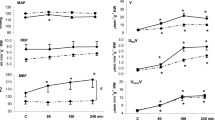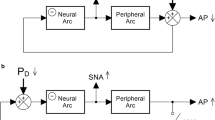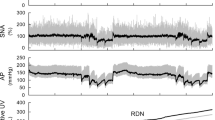Abstract
Relationships between changes in levels of catechols and directly recorded sympathetic nerve activity were examined using simultaneous measurements of renal sympathetic nerve activity and arterial and renal venous concentrations of norepinephrine (NE), dihydroxyphenylalanine (dopa), and dihydroxyphenylglycol (DHPG) during reflexive alterations in renal sympathetic nerve activity in anesthetized, adrenal-demedullated rats. Nitroprusside infusion increased renal sympathetic nerve activity by 90%, arterial levels of dopa by 96%, NE by 326%, and DHPG by 141%. Phenylephrine infusion increased arterial DHPG levels by 81% and decreased renal sympathetic nerve activity by 37% and NE levels by 26%; arterial dopa levels were unchanged. Ganglionic blockade by chlorisondamine (with concomitant phenylephrine infusion to maintain MAP) decreased renal sympathetic nerve activity by 65% and NE concentrations by 37%; arterial dopa concentrations were unchanged, and DHPG concentrations increased by 60%. Proportionate responses of arterial levels of NE were strongly related to proportionate changes in renal sympathetic nerve activity. Clearance of DHPG from arterial plasma was prolonged by phenylephrine-induced hypertension and by nitroprusside-induced hypotension. The results suggest that changes in arterial NE levels reflect changes in sympathetic activity; changes in dopa levels reflect changes in catecholamine biosynthesis; and changes in DHPG levels depend on reuptake of released NE and on hemodynamic factors affecting DHPG clearance.
Similar content being viewed by others
References
Eisenhofer, G., Goldstein, D. S., Ropchak, T. G., and Kopin, I. J. 1988 Source and physiological significance of plasma 3,4-dihydroxyphenylalanine in the rat. J. Neurochem. 51:1204–1213.
Goldstein, D. S., Udelsman, R., Eisehofer, G., Stull, R., Keiser, H. R., and Kopin, I. J. 1987. Neuronal source of plasma dihydrophenylalanine. J. Clin. Endoc. Metab. 64:856–861.
Goldstein, D. S., and Eisenhofer, G. 1988. Plasma catechols-what do they mean? News Physiol. Sci. 3:138–144.
Eisenhofer, G., Goldstein, D. S., Ropchak, T. G., Nguyen, H. Q., Keiser, H. R., and Kopin, I. J. 1988 Source and physiological significance of plasma 3,4-dihydroxyphenylglycol and 3-methoxy-4-hydroxyphenylglycol. J. Auton. Nerv. Syst. 24:1–14.
Goldstein, D. S., Eisenhofer, G., Stull, R., Folio, C. J., Keiser, H. R., and Kopin, I. J. 1988. Plasma dihydroxyphenylglycol and the intraneuronal disposition of norepinephrine in humans. J. Clin. Invest. 81:213–220.
Eisenhofer, G., Goldstein, D. S., Stull, R., Keiser, H. R., Sunderland, T., Murphy, D. L., and Kopin, I. J. 1986. Simultaneous liquid-chromatographic determination of 3,4-dihydroxyphenylglycol, catecholamines, and 3,4-dihydroxyphenylalanine in plasma and their responses to inhibition of monoamine oxidase. Clin. Chem. 32:2030–2033.
Winer, B. J. Statistical Principles in Experimental Design. New York, McGraw-Hill, 1971.
Ito, K., Sato, S., Shimamura, K., and Swenson, R. S. 1984. Reflex changes in sympatho-adrenal medullary functions in response to baroreceptor stimulation in anesthetized rats. J. Auton. Nerv. Sys. 10:295–303.
Kurosawa, M., Sato, A., Swenson, R. S., and Takahashi, Y. 1986. Sympatho-adrenal medullary functions in response to intracerebroventricularly injected corticotropin-releasing factor in anesthetized rats. Brain Res. 367:250–257.
Andersson, O. K., Hjemdahl, P., Persson, B., Wysocky, M., Agewall, S., and Wallin, G. 1988. Adrenaline-induced increases of plasma noradrenaline in man is due to an increased nerve activity rather than to prejunctional modulation of transmitter release. Proceedings, 12th Scientific Meeting of the International Society of Hypetension, Kyoto, Japan, May 22–26, Abstract #1089.
Bradley, T., Sollevi, A., and Lagerkranser, M. 1986. Effect of hypotension induced by sodium nitroprusside on catecholamine overflow in the canine kidney. Acta Physiol. Scand. 128:305–308.
Oliver, J. A., Pinto, J., Sciacca, R. R., and Cannon, P. J. 1980. Basal norepinephrine overflow into the renal vein: effect of renal nerve stimulation. Am. J. Physiol. 239:F371-F377.
Majewski, H., Hedler, L., Schurr, C., and Starke, K. 1984. Modulation of noradrenaline release in the pithed rabbit: a role for angiotensin II. J. Cardiovasc. Pharmacol. 6:888–896.
Richardson, P. D. I., and Withrington, P. G. 1981. Liver blood flow. II. Effects of drugs and hormones on liver blood flow. Gastroenterology 81:356–375.
Author information
Authors and Affiliations
Rights and permissions
About this article
Cite this article
Garty, M., Deka-Starosta, A., Chang, P.C. et al. Plasma levels of catechols during reflexive changes in sympathetic nerve activity. Neurochem Res 14, 523–531 (1989). https://doi.org/10.1007/BF00964913
Accepted:
Issue Date:
DOI: https://doi.org/10.1007/BF00964913




